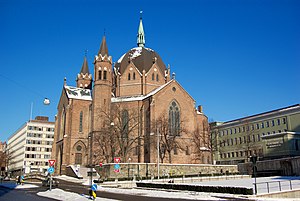
Oslo Cathedral — formerly Our Savior's Church — is the main church for the Church of Norway Diocese of Oslo, as well as the parish church for downtown Oslo. The present building dates from 1694 to 1697.

Røldal Stave Church is a parish church of the Church of Norway in Ullensvang Municipality in Vestland county, Norway. It is located in the village of Røldal. It is the church for the Røldal parish which is part of the Hardanger og Voss prosti (deanery) in the Diocese of Bjørgvin. The brown, wooden stave church was built in around the year 1250 using designs by an unknown architect. The church seats about 130 people and is built in a long church design. The church is a preserved historic museum, but it is still a regularly-used parish church that holds regularly scheduled worship services twice a month.

Tunsberg is a diocese of the Church of Norway. It includes all of the parishes located within the counties of Vestfold and Buskerud, with the cathedral located in the city of Tønsberg. The Diocese of Tunsberg consists of the cathedral deanery and eight rural deaneries.

Hallingby is a village in Ringerike municipality in the county of Buskerud, Norway.

Tromsø Cathedral is a cathedral of the Church of Norway located in the city of Tromsø in Tromsø Municipality in Troms county, Norway. The cathedral is the church for the Tromsø Domkirkens parish. It is the headquarters for the Tromsø domprosti (arch-deanery) and the Diocese of Nord-Hålogaland. This cathedral is notable since it is the only Norwegian protestant cathedral made of wood.
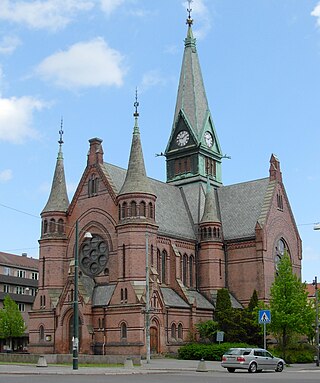
Sagene Church is located in Oslo, Norway. The church is one of the most rugged and prominent in Oslo. The church was built in gothic revival style and it was consecrated in 1891. It was designed by architect Christian Fürst in neo-Gothic style. There are 600 seats.

Holmen Church is the principal parish church for Sigdal municipality in the Diocese of Tunsberg. It is located at Prestfoss in Sigdal municipality, Buskerud county, Norway. Holmen Church is situated on a rocky mound with deciduous forest on the north side of the river Simoa. Access to the church is via Fv133 and Rv287.
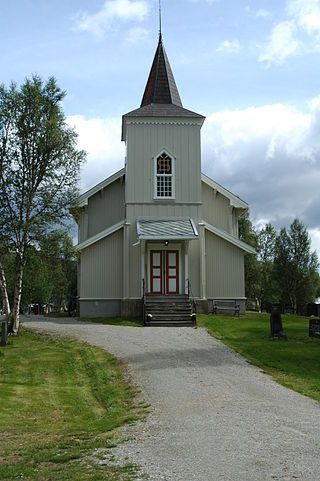
Brekken Church is a parish church of the Church of Norway in Røros municipality in Trøndelag county, Norway. It is located in the village of Brekken, at the eastern end of the lake Aursunden. It is the church for the Brekken parish which is part of the Gauldal prosti (deanery) in the Diocese of Nidaros. The gray, wooden church was built in a long church style in 1878 using plans drawn up by the architect Jacob Wilhelm Nordan. The building can hold about 200 people.

Røros Church or Bergstadens Ziir is a parish church of the Church of Norway in Røros municipality in Trøndelag county, Norway. Located in the town of Røros, it is the main church for the Røros parish which is part of the Gauldal prosti (deanery) in the Diocese of Nidaros. The octagonal, whitewashed stone church was built in 1784 using plans drawn up by the architect Peter Leonard Neumann from Trondheim. The church seats about 1,600 people, making it the 5th largest church within the Church of Norway. It is also ranked by Riksantikvaren as one of the ten most high-profile churches in Norway. Since 1999, Røros Church is known as one of the concert venues of the Norwegian Advent Concert Series.

Fredrikstad Cathedral is a cathedral located in the west of the city of Fredrikstad in Østfold county, Norway. It is the episcopal seat of the Diocese of Borg of the Church of Norway. The church was elevated to cathedral status in 1969 with the creation of the new Diocese of Borg. The cathedral has space for 1100 people.
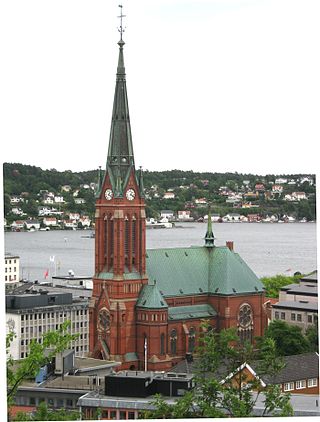
Trinity Church is a parish church of the Church of Norway in Arendal Municipality in Agder county, Norway. It is located in the central part of the town of Arendal. It is the church for the Trefoldighet parish. It is also the seat of the Arendal prosti (deanery) in the Diocese of Agder og Telemark. The red, brick, neo-Gothic church was built in a cruciform basilica design in 1888 using plans drawn up by the architect Christian Fürst. The church seats about 850 people.

Bragernes Church is a parish church at Drammen in Buskerud county, Norway.

Fagerborg Church is located south of Stensparken at Fagerborg in Oslo, Norway.
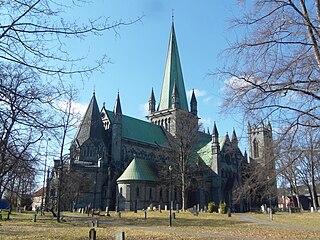
Church building in Norway began when Christianity was established there around the year 1000. The first buildings may have been post churches erected in the 10th or 11th century, but the evidence is inconclusive. For instance under Urnes Stave Church and Lom Stave Church there are traces of older post churches. Post churches were later replaced by the more durable stave churches. About 1,300 churches were built during the 12th and 13th centuries in what was Norway's first building boom. A total of about 3,000 churches have been built in Norway, although nearly half of them have perished. From 1620 systematic records and accounts were kept although sources prior to 1620 are fragmented. Evidence about early and medieval churches is partly archaeological. The "long church" is the most common type of church in Norway. There are about 1620 buildings recognized as churches affiliated with the Church of Norway. In addition, there are a number of gospel halls belonging to the lay movement affiliated with the Church of Norway as well as churches belonging to other Christian bodies. Until the 20th century, most churches were built from wood. 220 buildings are protected by law, and an additional 765 are listed as valuable cultural heritage.
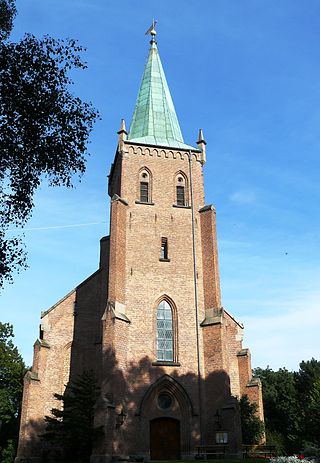
Østre Aker Church is a parish church at the neighborhood of Ulven in northeastern part of Oslo, Norway. The church building from 1860 in neo-Gothic style has exterior walls of brick, while the interior walls are covered with wood. The master masonry brothers Carl, Ferdinand and Albert Unger was commissioned to make the church the most alike Vestre Aker Church as possible. Østre Aker Church was consecrated 5 September 1860 with, among others, Prince Oscar present. Electricity was installed in 1925 and the church got chandeliers in 1928. Architect Helge Thiis was at the same time commissioned to make changes to improve the church interior.

Lovisenberg Church is a church in the neighborhood of Lovisenberg in the district of St. Hanshaugen in Oslo, Norway. The church is a basilica in Romanesque Revival style. The building is made of red brick and has a gable roof covered with slate. The bell tower is located to the side of the ridge and baptismal sacristy is to the right of the main entrance.
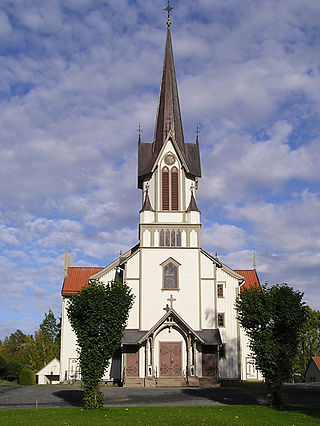
Bamble Church is a parish church of the Church of Norway in Bamble Municipality in Telemark county, Norway. It is located in the village of Bamble. It is one of the churches for the Bamble og Herre parish which is part of the Bamble prosti (deanery) in the Diocese of Agder og Telemark. The white, wooden church was built in a long church design in 1845 using plans drawn up by the architect Gustav Adolph Lammers. The church seats about 400 people.
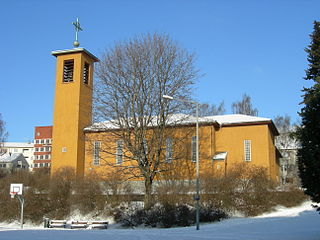
Iladalen Church is a church center, located in Oslo, Norway. The church was consecrated on May 22, 1941 by Bishop Eivind Berggrav as Iladalen småkirke. The church was then nicknamed the "Velsignelsens kirke" by the bishop.

Lambertseter Church is a church center in Oslo, Norway.

Lillehammer Church is a parish church of the Church of Norway in Lillehammer Municipality in Innlandet county, Norway. It is located in the town of Lillehammer. It is the church for the Lillehammer parish which is the seat of the Sør-Gudbrandsdal prosti (deanery) in the Diocese of Hamar. The red, brick church was built in a long church design in 1882 using plans drawn up by the architect Henrik Thrap-Meyer. The church seats about 650 people.
